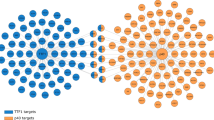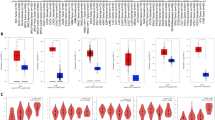Abstract
Genes of the polycomb group function by silencing homeotic selector genes that regulate embryogenesis. In mice, downregulation of one of the polycomb genes, bmi-1, leads to neurological alterations and severe proliferative defects in lymphoid cells, whilst bmi-1 overexpression, together with upregulation of myc-1, induces lymphoma. An oncogenic function has been further supported in primary fibroblast studies where bmi-1 overexpression induces immortalization due to repression of p16/p19ARF, and where together with H-ras, it readily transforms MEFs. It was the aim of this study to assess the expression of bmi-1 in resectable non-small cell lung cancer (NSCLC) in association with p16 and p14ARF (=human p19ARF). Tumours (48 resectable NSCLC (32 squamous, 9 adeno-, 2 large cell, 4 undifferentiated carcinomas and 1 carcinoid); stage I, 29, II, 7, III, 12; T1, 18, T2, 30; differentiation: G1 12, G2 19, G3 17) were studied by immunohistochemistry for protein expression and by comparative multiplex PCR for gene amplification analysis. In tumour-free, normal lung tissue from patients, weak – moderate bmi-1 staining was seen in some epithelial cells, lymphocytes, glandular cells and in fibroblasts, whereas blood, endothelial, chondrocytes, muscle cells and adipocytes did not exhibit any bmi-1 expression. In tumours, malignant cells were negative/weakly, moderately and strongly positive in 20, 22 and 6 cases, respectively. As assessed by multiplex PCR, bmi-1 gene amplification was not the reason for high-level bmi-1 expression. Tumours with moderate or strong bmi-1 expression were more likely to have low levels of p16 and p14ARF (P = 0.02). Similarly, tumours negative for both, p16 and p14ARF, exhibit moderate–strong bmi-1 staining. 58% of resectable NSCLC exhibit moderate–high levels of bmi-1 protein. The inverse correlation of bmi-1 and the INK4 locus proteins expression (p16/p14ARF) supports a possible role for bmi-1 misregulation in lung carcinogenesis. http://www.bjcancer.com © 2001 Cancer Research Campaign
Similar content being viewed by others
Article PDF
Change history
16 November 2011
This paper was modified 12 months after initial publication to switch to Creative Commons licence terms, as noted at publication
References
Alkema MJ, Wiegant J, Raap AK, Berns A and van Lohuizen M (1993) Characterization and chromosomal localization of the human proto-oncogene Bmi-1. Hum Mol Genet 2: 1597–1603
Alkema MJ, Bronk M, Verhoeven E, Otte A, van’t Veer LJ, Berns A and van Lohuizen M (1997a) Identification of bmi-1-interacting proteins as constituents of a multimeric mammalian polycomb complex. Genes Dev 11: 226–240
Alkema MJ, Jacobs H, van Lohuizen M and Berns A (1997b) Perturbation of B and T cell development and predisposition to lymphomagenesis in Emu Bmi1 transgenic mice require the Bmi1 RING finger. Oncogene 15: 899–910
Bea S, Ribas M, Hernandez JM, Bosch F, Pinyol M, Hernandez L, Garcia JL, Flores T, Gonzalez M, Lopez-Guillermo A, Piris MA, Cardesa A, Montserrat E, Miro R and Campo E (1999) Increased number of chromosomal imbalances and high-level DNA amplifications in mantle cell lymphoma are associated with blastoid variants. Blood 93: 4365–4374
Betticher DC, Heighway J, Haselton PS, Altermatt HJ, Ryder WD, Cerny T and Thatcher N (1996) Prognostic significance of CCND1 (cyclin D1) overexpression in primary resected non-small cell lung cancer. Br J Cancer 73: 294–300
Betticher DC, White GRM, Vonlanthen S, Liu X, Kappeler A, Altermatt HJ and Heighway J (1997) G1 control gene status is frequently altered in resectable non-small cell lung cancer. Int J Cancer 74: 556–562
Brunk BP, Martin EC and Adler PN (1991) Drosophila genes Posterior Sex Combs and Suppressor Two of Zeste encode proteins with homology to the murine bmi-1 oncogene. Nature 353: 351–353
Gould A (1997) Functions of mammalian Polycomb group and trithorax group related genes. Curr Opin Gen Develop 7: 488–494
Haupt Y, Alexander WS, Barri G, Klinken SP and Adams JM (1991) Novel zinc finger gene implicated as myc collaborator by retrovirally accelerated lymphomagenesis in Eμ-myc transgenic mice. Cell 65: 753–763
Jacobs JJL, Kieboom K, Marino S, DePinho RA and van LOHUIZEN (1999) The oncogene and Polycomb-group gene bmi-1 regulates cell proliferation and senescence through the ink4a locus. Nature 397: 164–168
Lessard J, Baban S and Sauvageau G (1998) Stage-specific expression of polycomb group genes in human bone marrow cells. Blood 91: 1216–1224
Paro R (1995) Propagating memory of transcriptional states. Trends Genet 11: 295–297
Pomerantz J, Schreiber-Agus N, Liegeois NJ, Silverman A, Alland L, Chin L, Potes J, Chen K, Orlow I and Lee HW (1998) The Ink4a tumor suppressor gene product, p19arf, interacts with MDM2 and neutralizes MDM2's inhibition of p53. Cell 92: 713–723
van der Lugt NM, Domen J, Linders K, van Roon M, Robanus-Maandag E, Te Riele H, van der Valk M, Deschamps J, Sofroniew M and van LOHUIZEN (1994) Posterior transformation, neurological abnormalities, and severe hematopoietic defects in mice with a _targeted deletion of the bmi-1 proto-oncogene. Genes Dev 8: 757–769
van Lohuizen M (1998) Functional analysis of mouse Polycomb group genes. Cell Mol Life Sci 54: 71–79
van Lohuizen M, Verbeeck S, Scheijen B, Wientjens E, van der Gulden H and Berns A (1991a) Identification of cooporating oncogenes in Eμ-myc transgenic mice by provirus tagging. Cell 65: 737–752
van Lohuizen M, Frasch M, Wientjens E and Berns A (1991b) Sequence similarity between the mammalian bmi-1 proto-oncogene and the Drosophila regulatory genes Psc and Su(z)2. Nature 353: 353–355
Voncken JW, Schweizer D, Aagaard L, Sattler L, Jantsch MF and van Lohuizen M (1999) Chromatin-association of the Polycomb group protein bmi-1 is cell cycle-regulated and correlates with its phophorylation status. J Cell Sci 112: 4627–4639
Vonlanthen S, Heighway J, Tschan MP, Borner MM, Altermatt HJ, Kappeler A, Tobler A, Fey MF, Thatcher N, Yarbrough WG and Betticher DC (1998) Expression of p16INK4a/p16alpha and p19ARF/p16beta is frequently altered in non-small cell lung cancer and correlates with p53 overexpression. Oncogene 17: 2779–2785
Weber JD, Taylor LJ, Roussel MF, Sherr CJ and Bar-Sagi D (1999) Nucleolar arf sequesters Mdm2 and activates p53. Nat Cell Biol 1: 20–26
Whyte P (1995) The retinoblastoma protein and its relatives. Semin Cancer Biol 6: 83–90
Zhang Y, Xiong Y and Yarbrough WG (1998) ARF promotes MDM2 degradation and stabilizes p53. ARF-INK4a locus deletion impairs both the Rb and p53 tumor suppression pathways. Cell 92: 725–734
Author information
Authors and Affiliations
Rights and permissions
From twelve months after its original publication, this work is licensed under the Creative Commons Attribution-NonCommercial-Share Alike 3.0 Unported License. To view a copy of this license, visit http://creativecommons.org/licenses/by-nc-sa/3.0/
About this article
Cite this article
Vonlanthen, S., Heighway, J., Altermatt, H. et al. The bmi-1 oncoprotein is differentially expressed in non-small cell lung cancer and correlates with INK4A-ARF locus expression. Br J Cancer 84, 1372–1376 (2001). https://doi.org/10.1054/bjoc.2001.1791
Received:
Accepted:
Published:
Issue Date:
DOI: https://doi.org/10.1054/bjoc.2001.1791
Keywords
This article is cited by
-
Long noncoding RNA DANCR knockdown inhibits proliferation, migration and invasion of glioma by regulating miR-135a-5p/BMI1
Cancer Cell International (2020)
-
Bmi1 drives hepatocarcinogenesis by repressing the TGFβ2/SMAD signalling axis
Oncogene (2020)
-
The Prognostic Significance of the BMI-1 and BAALC Genes in Adult Patients with Acute Myeloid Leukemia
Indian Journal of Hematology and Blood Transfusion (2020)
-
Evaluation of the expression of Bmi-1 stem cell marker in sinonasal melanomas and its correlation with the expression of cell cycle proteins
Surgical and Experimental Pathology (2019)
-
Upregulation of the proto-oncogene Bmi-1 predicts a poor prognosis in pediatric acute lymphoblastic leukemia
BMC Cancer (2017)



